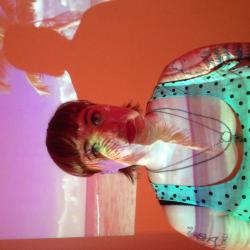Dance duets from graduates of P.A.R.T.S. in Brussels
Three students who graduated from the prestigious Performing Arts Research & Training Studio in Belgium this year are the first Icelanders to do so since renowned dancer Erna Ómarsdottir in 1998. They performed at Gaflar Leikhús on August 16, showing two duets that were developed during their tenure in the programme.
FOCUSED MOVEMENTS
In the first piece, ‘Out Of The Body’ Inga Huld Hákonardóttir and Rósa Ómarsdóttir entered the stage and stand parallel facing forward in simple jeans and shirted street clothes. Then began a segment of facile focused movements, their arms raised akimbo and curved upward, swinging in half circles around their heads. This pendulous repetition led to a series of hummed letters as they shifted their feet without raising them to reposition themselves.
The hummed letters revealed themselves to be a sentence, a Stravinsky quote—“music is by its very nature essentially powerless to express anything at all”—as they began a new rotation of poses. This sequence was repeated by each dancer with increasing physical dissonance between the two, creating a back-and-forth mantra which could have effectively carried on for the entire piece. This also recalled strong similarities to P.A.R.T.S. co-founder Anna Teresa De Keersmaeker’s seminal works set to Steve Reich’s phase music.
This was followed by a much weaker section of narrative performed by a single dancer, which seemed unfortunately convoluted and irrelevant to the work’s whole. All the while, at the back of the stage, the other continued performing a series of callisthenic motions, which quickly broke between linear and frantic, static to dynamic, firm to loose. An explanation by the second dancer using the first as a demonstration model of each movement they were employing gave a sense of calculation to the series which one could re-order each movement for a new equation. This also blended the name of the piece well into itself. The piece culminated with both dancers repeating the sequence again intermittently fast-slow-fast to a loud house music track that went on too long and lost dramatic effect, but was memorable nonetheless.
OLYMPIC SPORTS RE-ENACTED
After an almost imperceptible break, the second pair of dancers entered the stage for ‘Natural Order Is A Special Case.’ One followed the other and took an almost identical stance to the beginning of the first piece, except with the marked exaggeration of their shadows. Védís Kjartansdóttir and Louis Combeaud (from France) then launched into singing a da–da-dum-dum style impersonation of a bombastic baroque piece before relocating themselves to different parts of the stage and singing again at different volumes and speed in casual determination until they were each standing at one extreme of the stage.
Védís broke from this suddenly into a rapid, disjointed sequence travelling across the stage quickly in leaps and low angular shifts, as Louis then followed suit with an equally intricate and physically demanding, yet humourous, passage. Both returned to their positions and yet again began this previous part which seamlessly flowed into a grandiose display of athletics and mimicry. Both dancers calculatingly circling the stage area at its outer reaches, facing each other and silently performing what at times looked like mirrored-image tasks to empty handed re-enactments of elementary games or Olympic sports.
PARADIGMS
Just as sudden and subtly, both were nearly at stage front and breaking the fourth wall not just by facing towards the audience, but by looking into it with coy lechery, their left shoulders and hips just slightly swaying. The small movements spoke to something bigger, the anticipation created by restraint which paid off in full with a finale of synced, wide-breadth slalom jumps. Set to the same tune they hummed at the onset, with their leaps getting higher and wider and their facial expressions revealing true delight, the performance ended quite abruptly as the music turned off, they ceased their jumps and finished the song themselves.
Both performances followed similar paradigms in terms of structure and in their tone of lightness without being overtly comical, yet the second was better accomplished as a whole and held the engagement of the viewer by the dancers’ skill. A close eye should be kept on all of these dancers in years to come.
—
Dans dúettar took place at Gaflarleikhúsið on August 16. You can read more about P.A.R.T.S. at www.parts.be
The Reykjavík Dance Festival is ongoing: find out more at www.reykjavikdancefestival.is
Buy subscriptions, t-shirts and more from our shop right here!
















